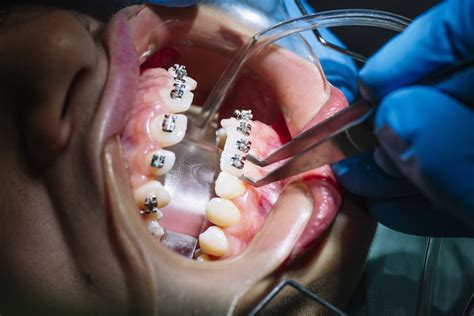How Do Braces Shift Your Teeth
Ronan Farrow
Apr 04, 2025 · 3 min read

Table of Contents
How Do Braces Shift Your Teeth? A Comprehensive Guide
Orthodontic treatment, commonly involving braces, is a transformative process that gradually realigns teeth and jaws. Understanding how braces achieve this is key to appreciating the complexity and effectiveness of this dental procedure. This guide delves into the mechanics behind teeth movement, offering a clear explanation of the process.
The Mechanics of Tooth Movement
Braces work by applying controlled pressure to your teeth over an extended period. This pressure isn't brute force; rather, it's a carefully calibrated force that encourages your teeth to move into their desired positions. The process involves several key components:
1. Brackets and Wires: The Power Duo
Brackets, small metal or ceramic squares, are bonded to the surface of each tooth. These brackets act as anchors for the archwire, a thin wire that runs along the entire row of teeth. The archwire applies gentle pressure to the brackets, guiding the teeth into their new positions.
2. Pressure and Bone Remodeling
The pressure exerted by the archwire isn't directly moving the teeth through the bone. Instead, it creates a force that stimulates the bone surrounding the tooth roots. This stimulation triggers a process called bone remodeling.
- Osteoclasts: Specialized cells called osteoclasts break down the bone on the side of the tooth root experiencing pressure. This creates space for the tooth to move.
- Osteoblasts: Simultaneously, osteoblasts, other specialized cells, build new bone on the opposite side of the tooth root, where there is less pressure. This anchors the tooth in its new position.
This continuous process of bone breakdown and rebuilding is what gradually shifts the teeth into their correct alignment. It’s a remarkably precise and natural process guided by the orthodontist's expertise.
3. The Role of Elastics and Other Accessories
Sometimes, additional components like elastics (rubber bands) are incorporated to provide extra pressure and guide the movement of specific teeth or jaws. These are often used to correct overbites, underbites, or crossbites. Other accessories, such as headgear or palatal expanders, might be employed to address more complex orthodontic issues.
The Timeline of Tooth Movement
The time it takes for braces to shift your teeth varies greatly depending on the complexity of the case and individual patient factors. Treatment typically lasts between 12 and 36 months. Regular check-ups with your orthodontist are crucial to monitor progress and make necessary adjustments to the archwire or other components.
Maintaining Your New Smile
Once your braces are removed, it’s vital to wear a retainer. Retainers prevent your teeth from shifting back to their original positions. Following your orthodontist's instructions regarding retainer wear is paramount to maintaining your beautiful, straight smile for years to come.
Choosing the Right Orthodontist
Selecting an experienced and qualified orthodontist is crucial for successful treatment. Look for an orthodontist with a strong reputation, positive patient reviews, and a comprehensive understanding of modern orthodontic techniques.
This detailed explanation helps you understand the complex yet fascinating process of how braces shift your teeth. Remember, this is a gradual, carefully controlled process aimed at creating a healthy and beautiful smile.
Featured Posts
Also read the following articles
| Article Title | Date |
|---|---|
| How Deep The Fathers Love For Us Chords Pdf | Apr 04, 2025 |
| How Fast Does Pine Sol Kill Grass | Apr 04, 2025 |
| How Far Am I From The Oklahoma State Line | Apr 04, 2025 |
| How Do Weather Conditions Affect Fishing Success | Apr 04, 2025 |
| How Do You Get To Whitehaven Beach | Apr 04, 2025 |
Latest Posts
-
How Hard Is Dental Assisting
Apr 04, 2025
-
How Hard Does Polymeric Sand Get
Apr 04, 2025
-
How Great Though Art Sheet Music
Apr 04, 2025
-
How Great Thou Art Trumpet Sheet Music
Apr 04, 2025
-
How Great Thou Art Sheet Music Trumpet
Apr 04, 2025
Thank you for visiting our website which covers about How Do Braces Shift Your Teeth . We hope the information provided has been useful to you. Feel free to contact us if you have any questions or need further assistance. See you next time and don't miss to bookmark.
